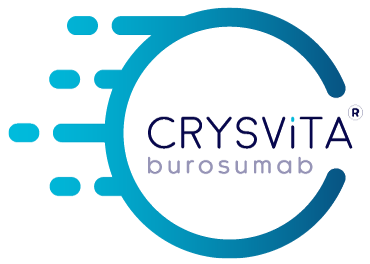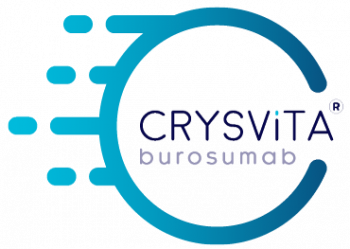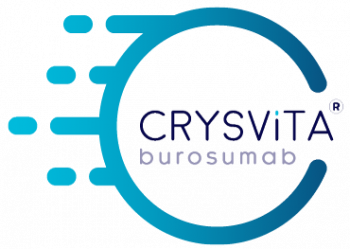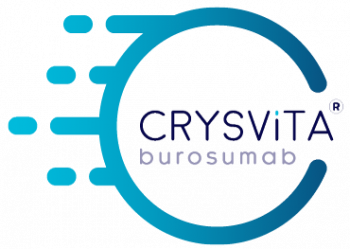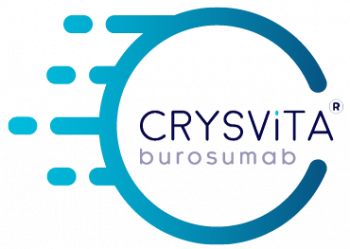크리스비타 제품 정보 요약본
CRYSVITA® Abbreviated Product Information
크리스비타® (burosumab) Malaysia Package Insert. September 2022, Version 1
INDICATIONS AND USAGE
크리스비타® is indicated for the treatment of X-linked hypophosphataemia, in children and adolescents aged 1 to 17 years with radiographic evidence of bone disease, and in adults.
DOSAGE AND ADMINISTRATION
Treatment should be initiated by a physician experienced in the management of patients with metabolic bone diseases. Oral phosphate and active vitamin D analogues (e.g. calcitriol) should be discontinued 1 week prior to initiation of treatment. The recommended starting dose in children and adolescents aged 1 to 17 years is 0.8 mg/kg of body weight given every two weeks. Doses should be rounded to the nearest 10 mg. The maximum dose is 90 mg. After initiation of treatment with burosumab, fasting serum phosphate should be measured every 2 weeks for the first month of treatment, every 4 weeks for the following 2 months and thereafter as appropriate. Fasting serum phosphate should also be measured 4 weeks after any dose adjustment. If fasting serum phosphate is within the reference range for age, the same dose should be maintained. The recommended starting dose in adults is 1.0 mg/kg of body weight, rounded to the nearest 10 mg up to a maximum dose of 90 mg, given every 4 weeks. After initiation of treatment with burosumab, fasting serum phosphate should be measured every 2 weeks for the first month of treatment, every 4 weeks for the following 2 months and thereafter as appropriate. Fasting serum phosphate should be measured 2 weeks after the previous dose of burosumab. If serum phosphate is within the normal range, the same dose should be continued. For subcutaneous use.
CONTRAINDICATIONS
Hypersensitivity to the active substance or to any of the excipients listed in section 6.1 of Package Insert. Concurrent administration with oral phosphate, active vitamin D analogs (see section 4.5 of Package Insert). Fasting serum phosphate above the normal range for age due to the risk of hyperphosphatemia (see section 4.4 of Package Insert). Patients with severe renal impairment or end stage renal disease.
WARNINGS AND PRECAUTIONS
Traceability: In order to improve the traceability of biological medicinal products, the name and the batch number of the administered product should be clearly recorded within the patient’s records. Ectopic mineralization: Ectopic mineralization, as manifested by nephrocalcinosis, has been observed in patients with XLH treated with oral phosphate and active vitamin D analogs; these medicinal products should be stopped at least 1 week prior to initiating burosumab treatment (see section 4.2 of Package Insert). Hyperphosphataemia: Levels of fasting serum phosphate should be monitored due to the risk of hyperphosphatemia. Serum parathyroid hormone: Increases in serum parathyroid hormone have been observed in some XLH patients during treatment with burosumab. Periodic measurement of serum parathyroid hormone is advised. Injection site reactions: Administration of burosumab may result in local injection site reactions. Administration should be interrupted in any patient experiencing severe injection site reactions (see section 4.8 of Package Insert) and appropriate medical therapy administered. Hypersensitivity: Burosumab must be discontinued if serious hypersensitivity reactions occur and appropriate medical treatment should be initiated. Excipient with known effect: This medicine contains 45.91 mg of sorbitol in each vial which is equivalent to 45.91 mg/ml.
UNDESIRABLE EFFECTS
The most common (>10%) adverse drug reactions reported in pediatric patients treated for up to 64 weeks during clinical trials were: injection site reactions (56%), cough (56%), headache (50%), pyrexia (43%), pain in extremity (40%), vomiting (39%), tooth abscess (35%), vitamin D decreased (32%), diarrhea (25%), rash (24%), nausea (15%), constipation (11%), dental caries (11%) and myalgia (11%). The most common adverse drug reactions reported in adult patients during clinical trials were: back pain (23%), headache (21%), tooth infection (19%), restless legs syndrome (13%), muscle spasms (12%), vitamin D decrease (15%) and dizziness (11%).
PLEASE REFER TO THE FULL PRESCRIBING INFORMATION BEFORE PRESCRIBING.
This material is for Healthcare Professionals Only.
